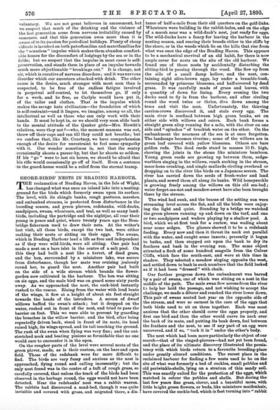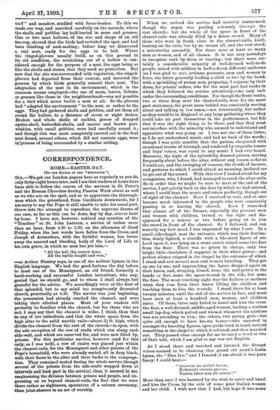SHORE-BIRDS' NESTS IN BRA.DING HARBOUR.
THE reclamation of Brading Haven, in the Isle of Wight, has changed what was once an inland lake into a nesting- ground for the birds which formerly swam upon its surface. The level, with its shingle banks, rough pastures, marshes, and embanked streams, is protected from disturbance in the breeding season, and green plovers, redshanks, wild-ducks, sandpipers, swans, wheatears, and teal, as well as many land- birds, including the partridge and the nightjar, all rear their young in peace and quiet, where twenty years ago the Bern- bridge fishermen used to draw their nets. At the writer's last visit, all these birds, except the two last, were either making their nests or sitting on their eggs. The swans, which in Brading Harbour lead a life as free and independent as if they were wild-birds, were all sitting. One pair had made a nest on a bare islet in the centre of a salt pool. On this they had built a nest like a turret, of dead grass, and the hen, surrounded by a miniature lake, was secure from disturbance, though her mate was cruising jealously round her, to guard the nest. Another pair had built on the side of a wide stream which bounds the flower- garden now cultivated in the harbour. The hen was sitting -on six eggs, and the male bird was on guard some sixty yards away. As we approached the nest, the cock-bird instantly rushed to the rescue. Rising from the water with loud beats of the wings, it flew at a height of about six feet straight towards the heads of the intruders. A screen of dwarf willows baffled the swan's attack ; but it dropped on the water, rushed out in front of the nest, and tried to pass the barrier on foot. This we were able to prevent by guarding the breaches in the willow barrier, and the bird, after being repeatedly driven back, stood in front of its mate, its head raised high, its wings spread, and its tail touching the ground. The rush of the swan when flying was very fine ; and the out- stretched neck and beating pinions so formidable that no one would care to encounter it in the open.
On the rougher parts of the level were several nests of the green plover, made, as is their custom, on the bare and open field. Those of the redshank were far more difficult to find. The birds are very fussy and anxious as the nest is approached, flying round and calling incessantly ; but the only nest found was in the centre of a tuft of rough grass, so carefully covered, that unless the track of the birds had been observed in the herbage round, the eggs would not have been detected. Near the redshanks' nest was a rabbit warren. The rabbits had discovered a sand-bed, though it was quite invisible and covered with grass, and migrated there, a dis- .
tance of half-a-mile from their old quarters on the golf-links. Wheatears were building in the rabbit-holes, and on the edge of a marsh near was a wild-duck's nest, just ready for eggs.
The wild-ducks have a fancy for leaving the harbour in the nesting season, and rearing their broods either in the cliffs by the shore, or in the woods which lie on the hills that rise from what was once the edge of the Brading Haven. This appears to be a mechanical survival of an old habit, for there is now ample cover for nests on the site of the old harbour. We found one of these nests by accidentally disturbing the sitting-bird in passing through the wood. She flew up from the side of a small damp hollow, and the nest, con- taining eight olive-brown eggs, lay under a bramble-bush, surrounded by primrose blossoms, and half-covered by dead grass. It was carefully made of grass and leaves, with a quantity of down for lining. Every evening the two ducks used to fly in from the harbour, and after circling round the wood twice or thrice, dive down among the trees and visit the nest. Unfortunately, the thieving carrion-crows discovered it, and stole every egg. The main river is confined between high green banks, set on either side with willows and osiers. Each bank forms a straight green alley running for a mile, with the river on one side and " splashes " of brackish water on the other. On the embankment the nearness of the sea is at once forgotten. The landscape becomes riverine ; some of the willows are in green leaf covered with yellow blossoms. Others are bare golden rods. The dead reeds stand in masses 10 ft. high, showing the joints in the stems like miniature bamboos. Young green reeds are growing up between them, sedge- warblers singing in the willows, roach sucking in the stream, moor-hens croaking, and single mallards circling overhead or dropping on to the river like birds on a Japanese screen. The river has carried down the seeds of fresh-water and land plants, and sowed them all along its banks. Wild honeysuckle is growing freely among the willows on this old sea-bed ; water forget-me-not and meadow-sweet have also been brought there by the stream.
The wind had sunk, and the beams of the setting sun were streaming level across the flat, and all the birds were enjoy- ing the light and quiet. Standing by a bridge we watched the green plovers running up and down on the turf, and one or two sandpipers and waders playing by a shallow pool. A bird, which we at first took for a curlew, was wading about near some sedges. The glasses showed it to be a redshank feeding. Every now and then it thrust its neck out parallel with the water, and caught some insects ; presently it began to bathe, and then stepped out upon the bank to dry its feathers and bask in the evening sun. The same object attracted a flock of some hundred seagulls from the Culver Cliffs, which face the south-east, and were at this time in shadow. They selected a meadow sloping opposite the west, and settled down to bask in such numbers that the field looked as if it had been "dressed" with chalk.
Our farther progress down the embankment was barred by a pair of swans, one of which was sitting on a nest in the middle of the path. The male swan flew across from the river t3 help her hold the passage, and not wishing to accept the challenge, we made a &Stour and reached the river lower down. This pair of swans nested last year on the opposite side of the stream, and were so earnest in the care of the eggs that both birds used to sit on them together. Each was most anxious that the other should cover the eggs properly, and first one bird and then the other would curve its neck over the back of its mate, and putting its beak down, feel between the feathers and the nest, to see if any part of an egg were uncovered, and if so, "tuck it in" under the other's body.
The nest which had been more particularly the object of our search—that of the ringed-plovers—had not yet been found, and the place of its ultimate discovery illustrated the persis- tency with which birds return to a favourite breeding-place under greatly altered conditions. The surest place in the reclaimed harbour for finding a few nests used to be on the site of what was formerly a bed of cockles, small pebbles and old periwinkle-shells, lying on a stratum of thin sandy soil. This was exactly suited for the protection of the eggs, which matched in colour the pebbles and shells. But during the last few years fine grass, clover, and a beautiful moss, with little blight green flowers, or buds, like miniature maidenhair, have covered the cockle-bed, which is fast turning into "rabbit turf" and meadow, studded with furze-bushes. To this we made our way, and searched carefully on the mounds, where the shells and pebbles lay half-buried in moss and grasses. One or two neat hollows, of the size and shape of an old tea-cup, showed that the birds had revisited the spot, and had been thinking of nest-making ; before long we discovered a, real nest, ready for the eggs to be laid. Where the ringed-plovers usually build, as on this ground in its old condition, the scratching out of a hollow is con- sidered enough for the purpose of a nest, the eggs being so like the shells and stones that they need no protection. But now that the site was surrounded with vegetation, the ringed- plovers had departed from their custom, and inverted the process by which birds generally conceal their nest. The adaptation of the nest to its environment, which is the common means employed—the use of moss, leaves, lichens, or grasses like those in the neighbourhood—was not possible for a bird which never builds a nest at all. So the plovers had "adapted the environment" to the nest, or rather to the eggs. They had gathered shells and pebbles, and set them all round the hollow, to a distance of seven or eight inches. Broken and whole shells of cockles, pieces of decayed oyster-shell, butterfish-shells, and mauve and brown peri- winkles, with small pebbles, were laid carefully round it; and though this was most completely carried out in the first zest found, several others, which did not contain eggs, were in'process of being surrounded by a similar setting.



















































 Previous page
Previous page